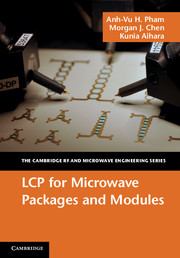Book contents
- Frontmatter
- Contents
- Preface
- 1 Introduction to electronic package engineering
- 2 Characteristics of liquid crystal polymer (LCP)
- 3 Fabrication techniques for processing LCP
- 4 LCP for wafer-level chip-scale MEMS
- 5 LCP for surface mount interconnects, packages, and modules
- 6 LCP for passive components
- 7 LCP for system design
- 8 LCP reliability
- Abbreviations, acronyms, and symbols
- Index
- References
4 - LCP for wafer-level chip-scale MEMS
Published online by Cambridge University Press: 05 July 2012
- Frontmatter
- Contents
- Preface
- 1 Introduction to electronic package engineering
- 2 Characteristics of liquid crystal polymer (LCP)
- 3 Fabrication techniques for processing LCP
- 4 LCP for wafer-level chip-scale MEMS
- 5 LCP for surface mount interconnects, packages, and modules
- 6 LCP for passive components
- 7 LCP for system design
- 8 LCP reliability
- Abbreviations, acronyms, and symbols
- Index
- References
Summary
As defined in IPC/JEDEC J-STD-012, chip-scale packaging (CSP) refers to a packaging method where the final package area dimensions are no larger than 1.2 times the die. Wafer-level packaging refers to a method where a wafer containing multiple chips is processed for packaging before the individual dies have been sawn-cut for separation [1]. While chip-scale packages have been widely available in high-volume production, hermetic packaging at the wafer level is still either at the research stage or in low-volume manufacturing.
The most popular wafer-level packaging technique is wafer-to-wafer bonding for the packaging of microelectromechanical system (MEMS) devices. Several techniques used by industry to package MEMS devices at the wafer level include epoxy seals, glass frit, glass-to-glass anodic bonding, and gold-to-gold bonding [4–9]. These techniques face two major problems. Firstly, organic materials outgas within the MEMS cavity during bonding processes, owing to the wetting compounds in the glass, gold, or epoxy layers. This contamination detrimentally affects the MEMS reliability. Secondly, most bonding processes utilize high temperatures (300 to 400°C), and this can degrade MEMS structures [10]. Furthermore, the available hermetic packages and ceramic or glass feed-throughs have significant losses at microwave frequencies, can be expensive, and add considerable weight to a system. Recent advances in low-temperature hermetic wafer-level packaging have shown promise for packaging multiple integrated circuits at wafer level [34]. One such process involves solder bonding, which combines the benefits of low-temperature conditions and thermodynamically stable eutectic bonding. Another viable alternative for packaging is an organic module, in which compact multilayer substrates house active and passive components; however, this presents even more challenges than those mentioned above. Although multilayer chip-on-flex modules using polyimide films are a proven technology for high-density packaging of microwave circuits [11, 12], polyimide is found to be incompatible with RF MEMS switch packaging owing to its high moisture absorption and high outgassing characteristics and the need to use high outgassing epoxies for lamination. In order to improve performance and provide ease of system integration, a hermetic MEMS package must be made with small, light-weight, planar interfaces constructed with MEMS-compatible materials. Thin-film plastic materials using liquid crystal polymer (LCP) are an attractive possibility for this application, owing to the low-temperature processing requirements for forming an interposer package.
- Type
- Chapter
- Information
- LCP for Microwave Packages and Modules , pp. 72 - 96Publisher: Cambridge University PressPrint publication year: 2012



